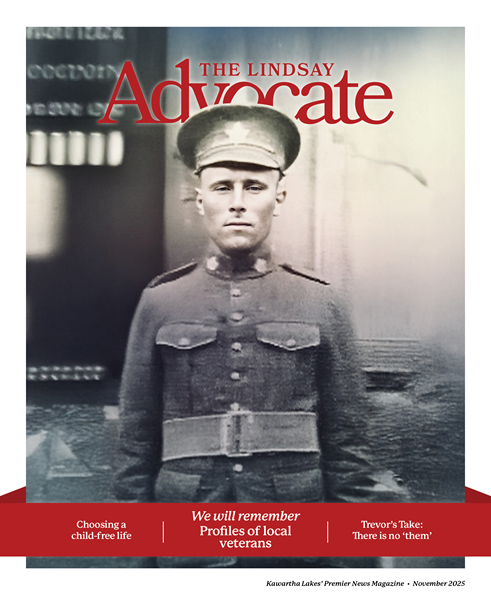Four generations of high school prep comes to a close

The installation of playground equipment on the grounds of Central Senior Public School earlier this past summer heralds a significant change in the history of public education here in Lindsay. Starting in September 2025, the venerable old institution will welcome Grades 4 to 8 French Immersion students – and will thus cease to be a Grades 7 and 8 intermediate school, a role it has held for 70 years.
Central was more than just another elementary school. It was for four generations of Lindsay residents a kind of preparatory institution, a way station en route to high school. Parkview Public School’s 2003 yearbook, prepared by that year’s graduating Grade 6 classes, reveals that a significant number of students were looking forward to having their own lockers at Central, as well as enjoying the freedom to leave the school grounds for lunch. For this writer, the creaking old wooden floors and Edwardian architecture were the big draws: to walk the halls of Central was to take a trip back in time.
Although it was constructed in 1910, Central traced its origins back to the Union Grammar School, an eccentric-looking Gothic Revival building that was located approximately mid-way between Central and what is now LCVI. Opened in 1863, the Union school served the needs of elementary school students until Central School was ready to welcome students nearly half a century later. (Alfred Lafferty, who served as the Union school’s headmaster from 1871 through 1872, would go on to become the first Black high school principal in Ontario.)

The red-brick Central School was opened with great fanfare on July 6, 1911. Local clergymen offered up prayers and readings from the Bible, while Thomas Stewart, chairman of the board of education, spoke glowingly about the importance of free public education. Distinguished by symmetrical massing, the new building sported 11 classrooms and was crowned with a belfry that remains in situ to this day.
Despite their seemingly spacious quarters, Lindsay’s elementary schools were becoming crowded by the late 1940s. Trying to mitigate classroom congestion, the school board approved a plan in 1954 that would see Central become a Grades 7 and 8 “senior school” starting in September of 1955. This plan also called for the elimination of two recesses and a shortening of Central’s lunch hour.
To smooth out the transition, space was initially provided at Central for a Grades 3-4 and Grades 5-6 combined class, respectively. Not many students can claim to have attended their elementary school twice, but this is exactly what happened to Linda Thomson as a result of these changes. Thomson was enroled at Central from 1952 through the middle part of that decade, after which she had to make the walk up to Alexandra Public School for Grade 6 before returning to Central for Grades 7 and 8.
Perhaps somewhat awkwardly, Thomson’s mother, Jean Tompkins, was also her classroom teacher. “Mom taught gym at Central,” Thomson recalls. “We learned to dance with the boys’ gym class to be ready for our first close encounter of the opposite sex – the ‘Sadie Hawkins’ dance (an event in which girls invited boys to a school dance, rather than the other way around). If adding strings of numbers was frightening, inviting a boy to the dance was even more so.”
Population growth in Lindsay spurred the construction of an unsightly-looking addition to Central in 1962, complete with a new gymnasium and new classrooms. By the mid-1960s, its identity as an intermediate school was becoming firmly entrenched among students, who were by that point wearing school uniforms. A regular column authored by the “Central Senior Press Club” appeared in the pages of the Lindsay Daily Postthroughout that decade, and it offers some interesting – and amusing – insights about life at Central. “This year a graduation will not be held,” intoned a disappointed correspondent on June 3, 1965. “The staff felt that in other years the girls outdid themselves with expensive fussy dresses and high heels that did not suit a grade eight student.”
Central was also long known for its arts programming, with music classes being conducted by Mrs. Erma Garbig through the 1960s. By 1963, its choir numbered 80 voices and when it wasn’t performing in the school auditorium, it would join the Kinsmen Band at its Moods in Music concerts. “I think my favourite memories involve the bands, choirs, and musicals,” says Eric Smeaton, who taught music at Central for several years in the first part of this century. “There were rehearsals pretty much each day, so you really connected with the students and became a family of sorts,” Smeaton reminisces.
Those musicals were among the memories that have stuck with Katherine Eddy, who graduated from Central 20 years ago. “My two years at Central Senior were a special time,” she tells the Advocate. “I couldn’t have asked for better teachers and our principal, Mr. Sanderson, who really cared about their students and their success. The memories made in choir, taking part in The Music Man and school concerts, and simply walking the halls will last a lifetime.”
Though an intermediate school no more, Central’s legacy as Lindsay’s answer to a preparatory school will assuredly live on as it begins the next chapter in its long and intriguing history.




